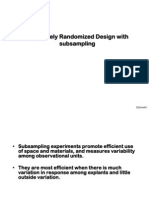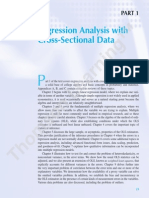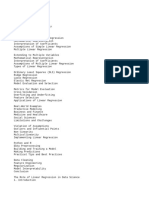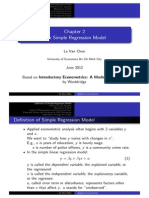Lecture 7
Uploaded by
ABHILASH MSLecture 7
Uploaded by
ABHILASH MSAIL 7310: MACHINE LEARNING FOR ECONOMICS
Lecture 7
10th August, 2023
AIL 7310: ML for Econ Lecture 7 1 / 11
Statistical Inference
What is statistical inference?
AIL 7310: ML for Econ Lecture 7 2 / 11
Statistical Inference
What is statistical inference?
Statistical Inference is the process of drawing conclusions about an
underlying population using a subset or sample of the data.
AIL 7310: ML for Econ Lecture 7 2 / 11
Statistical Inference
What is statistical inference?
Statistical Inference is the process of drawing conclusions about an
underlying population using a subset or sample of the data.
Statistical Inference is necessary to understand the exact nature of the
relationship (f ) between the predictors and response. This is important is
making decisions both in businesses and in policy.
AIL 7310: ML for Econ Lecture 7 2 / 11
Statistical Inference
What is statistical inference?
Statistical Inference is the process of drawing conclusions about an
underlying population using a subset or sample of the data.
Statistical Inference is necessary to understand the exact nature of the
relationship (f ) between the predictors and response. This is important is
making decisions both in businesses and in policy.
Note: Statistical Inference is a vast literature (over 200 year old) and is
the subject of numerous textbooks. In this course, we will only focus on a
small part of it.
AIL 7310: ML for Econ Lecture 7 2 / 11
Statistical Inference
What is statistical inference?
Statistical Inference is the process of drawing conclusions about an
underlying population using a subset or sample of the data.
Statistical Inference is necessary to understand the exact nature of the
relationship (f ) between the predictors and response. This is important is
making decisions both in businesses and in policy.
Note: Statistical Inference is a vast literature (over 200 year old) and is
the subject of numerous textbooks. In this course, we will only focus on a
small part of it.
We will focus on a linear model estimated using ordinary least squares.
AIL 7310: ML for Econ Lecture 7 2 / 11
Simple Linear Regression Model
We wish to understand the relation between x and y in the population
using a simple linear regression model given by
y = β0 + β1 x + u (1)
In the inference setting, we use different terminology to describe these
variables.
AIL 7310: ML for Econ Lecture 7 3 / 11
Simple Linear Regression Model
We wish to understand the relation between x and y in the population
using a simple linear regression model given by
y = β0 + β1 x + u (1)
In the inference setting, we use different terminology to describe these
variables.
y x
Dependent variable Independent variable, Covariates
Explained Variable Explanatory variable
Regressand Regressor
AIL 7310: ML for Econ Lecture 7 3 / 11
Simple Linear Regression Model
The variable u in eq. (1) is called the error term or disturbance term. It
represents factors other than x that affect y i.e. the unobserved factors.
AIL 7310: ML for Econ Lecture 7 4 / 11
Simple Linear Regression Model
The variable u in eq. (1) is called the error term or disturbance term. It
represents factors other than x that affect y i.e. the unobserved factors.
If all other factors are kept constant so that the change in u is 0 ∆u = 0,
then x has a linear effect on y .
∆y = β1 ∆x
Thus the change in y is simply β1 multiplied by change in x. β1 is the
slope parameter. This slope parameter is of primary importance in
econometrics. β0 is the intercept parameter (also called constant term)
although not central to econometrics analysis it is very useful in some
cases.
AIL 7310: ML for Econ Lecture 7 4 / 11
Simple Linear Regression Model
As long as the intercept β0 is included in the model, we can assume that
the average value of u in the population is zero
E (u) = 0 (2)
This assumption simply tells us about the distribution of unobserved
factors in the population, nothing about the relation between x and u.
AIL 7310: ML for Econ Lecture 7 5 / 11
Simple Linear Regression Model
As long as the intercept β0 is included in the model, we can assume that
the average value of u in the population is zero
E (u) = 0 (2)
This assumption simply tells us about the distribution of unobserved
factors in the population, nothing about the relation between x and u.
How do we look at the relation between x and u?
AIL 7310: ML for Econ Lecture 7 5 / 11
Simple Linear Regression Model
As long as the intercept β0 is included in the model, we can assume that
the average value of u in the population is zero
E (u) = 0 (2)
This assumption simply tells us about the distribution of unobserved
factors in the population, nothing about the relation between x and u.
How do we look at the relation between x and u?
A natural way would be to use correlation coefficient. But correlation only
measures linear dependence. It would be possible for u to be uncorrelated
with x and still be correlation with functions of x , such as x 2 . So the
assumption of u being uncorrelated with x is not enough here as it can
cause problems for interpreting the model and deriving statistical
properties.
AIL 7310: ML for Econ Lecture 7 5 / 11
Simple Linear Regression Model
We assume that the average value of u does not depend on the value of x.
E (u|x) = E (u) (3)
Equation 3 says that the average value of unobservables is the same across
all slices of the population determined by x and this common average is
equal to the average of u over the entire population.
AIL 7310: ML for Econ Lecture 7 6 / 11
Simple Linear Regression Model
We assume that the average value of u does not depend on the value of x.
E (u|x) = E (u) (3)
Equation 3 says that the average value of unobservables is the same across
all slices of the population determined by x and this common average is
equal to the average of u over the entire population.
Combining equation 2 and equation 3 we get the zero conditional mean
assumption
E (u|x) = 0 (4)
AIL 7310: ML for Econ Lecture 7 6 / 11
Simple Linear Regression Model
The zero conditional mean assumption gives β1 another interpretation.
Taking the expected value of equation (1) conditional on x and using
E (u|x) = 0 gives
E (y |x) = β0 + β1 x (5)
Equation (5) shows the population regression line. E (y |x) is a linear
function of x. This linearity means that a one-unit increase in x changes
the expected value of y by the amount β1 .
AIL 7310: ML for Econ Lecture 7 7 / 11
Simple Linear Regression Model
The zero conditional mean assumption gives β1 another interpretation.
Taking the expected value of equation (1) conditional on x and using
E (u|x) = 0 gives
E (y |x) = β0 + β1 x (5)
Equation (5) shows the population regression line. E (y |x) is a linear
function of x. This linearity means that a one-unit increase in x changes
the expected value of y by the amount β1 .
Note: Eq (5) tells us how the average value of y changes with x. It does
not say that y equals β0 + β1 x for all units in the population.
AIL 7310: ML for Econ Lecture 7 7 / 11
Simple Linear Regression Model
The zero conditional mean assumption gives β1 another interpretation.
Taking the expected value of equation (1) conditional on x and using
E (u|x) = 0 gives
E (y |x) = β0 + β1 x (5)
Equation (5) shows the population regression line. E (y |x) is a linear
function of x. This linearity means that a one-unit increase in x changes
the expected value of y by the amount β1 .
Note: Eq (5) tells us how the average value of y changes with x. It does
not say that y equals β0 + β1 x for all units in the population.
The piece β0 + β1 x which represents E (y |x) is called the systematic part
of y i.e. the part of y that is explained by x. u represents the unsystematic
part or the part that isn’t explained by x.
AIL 7310: ML for Econ Lecture 7 7 / 11
Simple Linear Regression Model
Now we turn to the issue of how to estimate β0 and β1 in equation (1).
AIL 7310: ML for Econ Lecture 7 8 / 11
Simple Linear Regression Model
Now we turn to the issue of how to estimate β0 and β1 in equation (1).
To do this we take a random sample of size n from the population.
AIL 7310: ML for Econ Lecture 7 8 / 11
Simple Linear Regression Model
Now we turn to the issue of how to estimate β0 and β1 in equation (1).
To do this we take a random sample of size n from the population.
Since the data come from eq. (1), we can write
yi = β0 + β1 xi + ui (6)
for each i. Here ui is the error term for observation i because it contains
factors other the xi affecting yi .
AIL 7310: ML for Econ Lecture 7 8 / 11
Simple Linear Regression Model
We will use the previous assumption in eq. (2) E (u) = 0 and an important
implication of assumption eq. (3) : u is uncorrelated with x.
AIL 7310: ML for Econ Lecture 7 9 / 11
Simple Linear Regression Model
We will use the previous assumption in eq. (2) E (u) = 0 and an important
implication of assumption eq. (3) : u is uncorrelated with x.
Therefore u has 0 expected value and that the covariance between x and u
is zero.
AIL 7310: ML for Econ Lecture 7 9 / 11
Simple Linear Regression Model
We will use the previous assumption in eq. (2) E (u) = 0 and an important
implication of assumption eq. (3) : u is uncorrelated with x.
Therefore u has 0 expected value and that the covariance between x and u
is zero.
E (u) = 0 (7)
AIL 7310: ML for Econ Lecture 7 9 / 11
Simple Linear Regression Model
We will use the previous assumption in eq. (2) E (u) = 0 and an important
implication of assumption eq. (3) : u is uncorrelated with x.
Therefore u has 0 expected value and that the covariance between x and u
is zero.
E (u) = 0 (7)
Cov (x, u) = E (xu) = 0 (8)
Rewriting the above equations in terms of observables we get
E (y − β0 − β1 x) = 0 (9)
AIL 7310: ML for Econ Lecture 7 9 / 11
Simple Linear Regression Model
We will use the previous assumption in eq. (2) E (u) = 0 and an important
implication of assumption eq. (3) : u is uncorrelated with x.
Therefore u has 0 expected value and that the covariance between x and u
is zero.
E (u) = 0 (7)
Cov (x, u) = E (xu) = 0 (8)
Rewriting the above equations in terms of observables we get
E (y − β0 − β1 x) = 0 (9)
E [x(y − β0 − β1 x)] = 0 (10)
AIL 7310: ML for Econ Lecture 7 9 / 11
Simple Linear Regression Model
Given a sample of data, we choose estimates βˆ0 and βˆ1 to solve the
sample counterparts of eq (9) and eq(10).
n
1X
(yi − βˆ0 − βˆ1 xi ) = 0 (11)
n
i=1
AIL 7310: ML for Econ Lecture 7 10 / 11
Simple Linear Regression Model
Given a sample of data, we choose estimates βˆ0 and βˆ1 to solve the
sample counterparts of eq (9) and eq(10).
n
1X
(yi − βˆ0 − βˆ1 xi ) = 0 (11)
n
i=1
n
1X
xi (yi − βˆ0 − βˆ1 xi ) = 0 (12)
n
i=1
This is the method of moments approach to estimation.
AIL 7310: ML for Econ Lecture 7 10 / 11
Simple Linear Regression Model
These two equations (11) and (12) can be solved to get βˆ0 and βˆ1 .
Pn
(x − x̄)(yi − ȳ )
ˆ
β1 = i=1 Pn i 2
(13)
i=1 (xi − x̄)
AIL 7310: ML for Econ Lecture 7 11 / 11
Simple Linear Regression Model
These two equations (11) and (12) can be solved to get βˆ0 and βˆ1 .
Pn
(x − x̄)(yi − ȳ )
ˆ
β1 = i=1 Pn i 2
(13)
i=1 (xi − x̄)
βˆ0 = ȳ − βˆ1 x̄ (14)
These are called the ordinary least squares estimates (OLS) of β1 and β0
AIL 7310: ML for Econ Lecture 7 11 / 11
You might also like
- Unit 9 Simple Linear Regression: StructureNo ratings yetUnit 9 Simple Linear Regression: Structure22 pages
- Theme 2 Ordinary Least Squares RegressionNo ratings yetTheme 2 Ordinary Least Squares Regression10 pages
- The Simple Regression Model (2 Variable Model) : Empirical Economics 26163 Handout 1No ratings yetThe Simple Regression Model (2 Variable Model) : Empirical Economics 26163 Handout 19 pages
- Lecture3-Enriching the Linear Models Slides-AnnotatedNo ratings yetLecture3-Enriching the Linear Models Slides-Annotated42 pages
- Regression Analysis With Cross-Sectional DataNo ratings yetRegression Analysis With Cross-Sectional Data0 pages
- Simple Regression Model: Erbil Technology InstituteNo ratings yetSimple Regression Model: Erbil Technology Institute9 pages
- ©the Mcgraw-Hill Companies, Inc. 2008 Mcgraw-Hill/IrwinNo ratings yet©the Mcgraw-Hill Companies, Inc. 2008 Mcgraw-Hill/Irwin20 pages
- Statistical Modelling of Epidemiological DataNo ratings yetStatistical Modelling of Epidemiological Data87 pages
- (Indian Economics Services) (Econometrics) 05. Functional Forms of Regression Models PDFNo ratings yet(Indian Economics Services) (Econometrics) 05. Functional Forms of Regression Models PDF8 pages
- (Bruderl) Applied Regression Analysis Using StataNo ratings yet(Bruderl) Applied Regression Analysis Using Stata73 pages
- Lecture8-Estimating the Linear Causal Model I -Slides annotatedNo ratings yetLecture8-Estimating the Linear Causal Model I -Slides annotated27 pages
- Chapter - Two - Simple Linear Regression - Final EditedNo ratings yetChapter - Two - Simple Linear Regression - Final Edited28 pages
- Statistics and Econometrics 55f4b3f70d16d54.36630863No ratings yetStatistics and Econometrics 55f4b3f70d16d54.3663086320 pages
- Lecture 2-2_Simple Linear Regression (One Regressor)No ratings yetLecture 2-2_Simple Linear Regression (One Regressor)22 pages
- Module 2b - Bivariate Association of Data - Part IINo ratings yetModule 2b - Bivariate Association of Data - Part II25 pages
- What Is Econometrics?: (Ref: Wooldridge, Chapter 1)No ratings yetWhat Is Econometrics?: (Ref: Wooldridge, Chapter 1)11 pages
- Student's Solutions Manual and Supplementary Materials for Econometric Analysis of Cross Section and Panel Data, second editionFrom EverandStudent's Solutions Manual and Supplementary Materials for Econometric Analysis of Cross Section and Panel Data, second editionNo ratings yet
- DPB 1013 - Statistic Correlation and Linear RegressionNo ratings yetDPB 1013 - Statistic Correlation and Linear Regression23 pages
- Metodologia UENF - Social Science Methodology - A Criterial Framework - 01No ratings yetMetodologia UENF - Social Science Methodology - A Criterial Framework - 01363 pages
- 1639 GCS1005A NguyenNgocPhu GCS210331 Assignment1No ratings yet1639 GCS1005A NguyenNgocPhu GCS210331 Assignment121 pages
- The Effects of Excessive Gadget Use On Grade 11 Students Sleeping Schedules - Service Group 6No ratings yetThe Effects of Excessive Gadget Use On Grade 11 Students Sleeping Schedules - Service Group 616 pages
- Business Statistics Bsa Day Program All ChaptersNo ratings yetBusiness Statistics Bsa Day Program All Chapters491 pages
- The Risk of Determining Risk With Multivariable ModelsNo ratings yetThe Risk of Determining Risk With Multivariable Models10 pages
- Demand Forecasting and Inventory Control A Simulation Study On Automotive Spare Parts PDFNo ratings yetDemand Forecasting and Inventory Control A Simulation Study On Automotive Spare Parts PDF16 pages
- Cambridge International AS & A Level Mathematics: Probability & Statistics 2No ratings yetCambridge International AS & A Level Mathematics: Probability & Statistics 247 pages
- The Simple Regression Model (2 Variable Model) : Empirical Economics 26163 Handout 1The Simple Regression Model (2 Variable Model) : Empirical Economics 26163 Handout 1
- Lecture3-Enriching the Linear Models Slides-AnnotatedLecture3-Enriching the Linear Models Slides-Annotated
- Simple Regression Model: Erbil Technology InstituteSimple Regression Model: Erbil Technology Institute
- ©the Mcgraw-Hill Companies, Inc. 2008 Mcgraw-Hill/Irwin©the Mcgraw-Hill Companies, Inc. 2008 Mcgraw-Hill/Irwin
- (Indian Economics Services) (Econometrics) 05. Functional Forms of Regression Models PDF(Indian Economics Services) (Econometrics) 05. Functional Forms of Regression Models PDF
- Lecture8-Estimating the Linear Causal Model I -Slides annotatedLecture8-Estimating the Linear Causal Model I -Slides annotated
- Chapter - Two - Simple Linear Regression - Final EditedChapter - Two - Simple Linear Regression - Final Edited
- Statistics and Econometrics 55f4b3f70d16d54.36630863Statistics and Econometrics 55f4b3f70d16d54.36630863
- Lecture 2-2_Simple Linear Regression (One Regressor)Lecture 2-2_Simple Linear Regression (One Regressor)
- Module 2b - Bivariate Association of Data - Part IIModule 2b - Bivariate Association of Data - Part II
- What Is Econometrics?: (Ref: Wooldridge, Chapter 1)What Is Econometrics?: (Ref: Wooldridge, Chapter 1)
- Student's Solutions Manual and Supplementary Materials for Econometric Analysis of Cross Section and Panel Data, second editionFrom EverandStudent's Solutions Manual and Supplementary Materials for Econometric Analysis of Cross Section and Panel Data, second edition
- DPB 1013 - Statistic Correlation and Linear RegressionDPB 1013 - Statistic Correlation and Linear Regression
- Metodologia UENF - Social Science Methodology - A Criterial Framework - 01Metodologia UENF - Social Science Methodology - A Criterial Framework - 01
- The Effects of Excessive Gadget Use On Grade 11 Students Sleeping Schedules - Service Group 6The Effects of Excessive Gadget Use On Grade 11 Students Sleeping Schedules - Service Group 6
- The Risk of Determining Risk With Multivariable ModelsThe Risk of Determining Risk With Multivariable Models
- Demand Forecasting and Inventory Control A Simulation Study On Automotive Spare Parts PDFDemand Forecasting and Inventory Control A Simulation Study On Automotive Spare Parts PDF
- Cambridge International AS & A Level Mathematics: Probability & Statistics 2Cambridge International AS & A Level Mathematics: Probability & Statistics 2

























































































